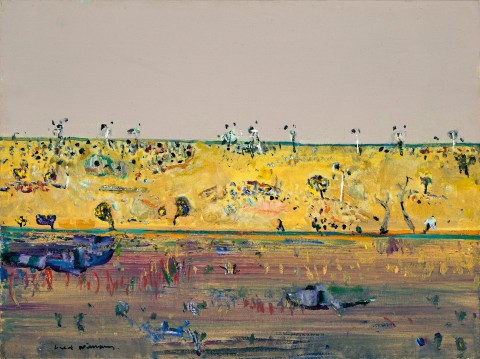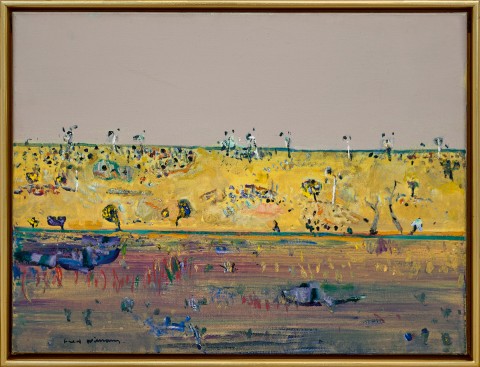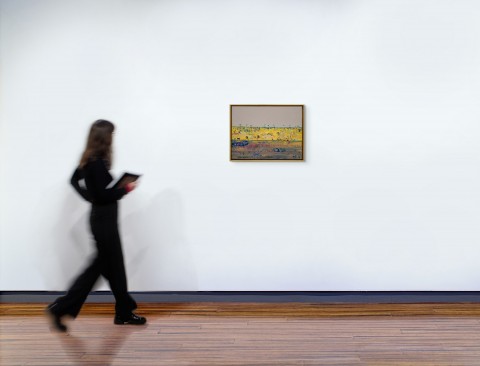SUMMER LANDSCAPE, LYSTERFIELD, 1973
FRED WILLIAMS
oil on canvas
46.0 x 61.0 cm
signed lower left: Fred Williams.
inscribed on stretcher verso: 196
Estate of the artist (LW196)
Rex Irwin Art Dealer, Sydney
Private collection, United Kingdom, acquired from the above in 1991
Fred Williams: Small Pictures, Rex Irwin Art Dealer, 7 May - 15 June 1991, cat. 15 (as ‘Summer Landscape, Lysterfield’, 1972)
We are grateful to Lyn Williams for her assistance with this catalogue entry.
Recent research of the artist's diaries has now recorded this work in the Williams database as Summer Landscape, 1973.
The 1960s began optimistically for Fred Williams. In 1963 he was invited to join the stable of artists represented by Sydney art dealer, Rudy Komon, and the monthly retainer he received gave Williams and his wife, Lyn, the financial confidence to buy a house at Upwey in the Dandenong Ranges. That same year Williams was awarded the Helena Rubinstein Travelling Art Scholarship, spending seven months in Europe in 1964. The following year was also significant – ‘for the first time [Williams] was able to paint full-time. The concentration and energy, and the time he now brought to his art, resulted in four years of astonishing variety and contrast in his painting.’1
From the beginning of his career Williams drew on his experience of the surrounding world as the source of subject matter for his art and the landscape of Upwey naturally featured in his paintings at this time. From mid-1965, nearby Lysterfield, which was just a short drive from his home, became a regular destination for outdoor painting trips. James Mollison, the artist’s great friend who accompanied him on some of these excursions, described the area at the time as ‘sparsely settled country, with gently rolling hills and scrubby paddocks – fenced, but otherwise showing few signs of habitation.’2 It was the perfect subject for an artist who used his immediate surroundings as a jumping off point for images which distilled the landscape to its essential elements, and in the process, created archetypal images which have become part of our collective visual memory.
The broad open country depicted in Summer Landscape, Lysterfield, 1972 is divided into three horizontal bands. The deep foreground in the lower section of the picture is painted in warm, variegated tones and enlivened by a series of short, predominantly vertical brushstrokes, which represent sparse, low grassy growth around pools of water. The middle band, with a bright, sandy-coloured ground, sits below a decisive horizon line. The top third of the picture is devoted to the depiction of the sky and painted in a moody grey, captures the familiar heat, humidity and stillness of high summer in Australia. The hieroglyphic-like marks that Williams used to describe the scrubby growth across the hillside, and the trees lining the horizon, are distinctively his, and typical of what Patrick McCaughey described as ‘his refined method of painting’ which was by this time, ‘as spontaneous as handwriting.’3 What particularly stands out in this painting however is Williams’ great skill as a colourist. During the late 1960s and into the 1970s he expanded his palette so that it included a range of vivid and often unmixed colours, and this work demonstrates his ability to merge the subtle, earthy tones of the underpainting – which are so readily associated with the Australian landscape – with touches of brilliant colour, especially yellow and orange, bringing the image to life and engaging the viewer in the living energy and rich detail of the scene.
1. McCaughey, P., Fred Williams 1927 – 1982, Murdoch Books, Sydney, revised edition, 1996, p. 166
2. Mollison, J., Fred Williams: A Singular Vision, Australian National Gallery and Oxford University Press, Canberra, 1989, p. 100
3. McCaughey, op. cit., p. 184
KIRSTY GRANT


